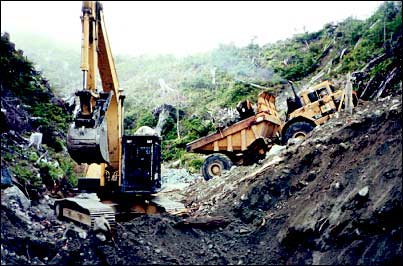|
Forest Road Deactivation Practices
|
|
in the Pacific Northwest
|


|
|
| 22 - Metal Culvert Removal
|
Sequence of Activities, Removal of Deep Fills |
Be aware of general considerations and site specific issues and use them to develop a work plan.
Suggested Sequence of Activities for Metal Culvert Removal
- Know the water quality issues before deactivation starts.
- Divert water flows, if at all practical, to work in the dry. However, in steep terrain, do not simply direct water down the ditch.
- Install sediment control downstream from the culvert.
- Remove the road fill from the vicinity of the culvert until the two ends of the culvert are visible.
- Remove all surfacing from the top of the culvert.
- Excavate a cross-ditch immediately next to the culvert, from outlet to inlet. Leave some material on the upstream side (inlet) to maintain the water flow through the pipe.
- Slope the channel and armour the base of the cross-ditch.
- Divert the flow from the culvert to the armoured channel; move to the camp side of the culvert.
- Remove the culvert and excavate the near side of the road fill; armour as required.
- Remove trapped sediment and remove sediment control devices once the water runs clear through the deactivated site.

Removal of Culverts in Deep Fills
In addition to the above, you should follow the steps below. Estimate the amount of fill to be removed and determine disposal sites and endhaul machine requirements if needed. Start work at the woods end.
- Remove surfacing and fill material to the top of the culvert.
- Slope side walls gently if vehicle access is to be maintained.
- Expose and remove culvert, and complete cross-ditch on far side.
- Move machine to near side; complete cross-ditch excavation.
- Armour base of cross-ditch and outlet as required.
Completing work from both sides helps create equal slope angles!
Deactivation of Disposal Sites
Remember to deactivate disposal sites of endhauled materials. This involves compacting materials, establishing stable slope angles, and preventing water from pooling on top of the disposed material. Pest management may require that logs, stumps and branches are covered with mineral soil. Otherwise, cover endhaul with top soil and woody debris and establish revegetation as quickly as possible.
| 22 - Metal Culvert Removal
|
|
|
 22 Metal Culvert Removal 22 Metal Culvert Removal
|
©1999 - 2002 Flip Productions Limited
Used with permission by CulvertBC
|
